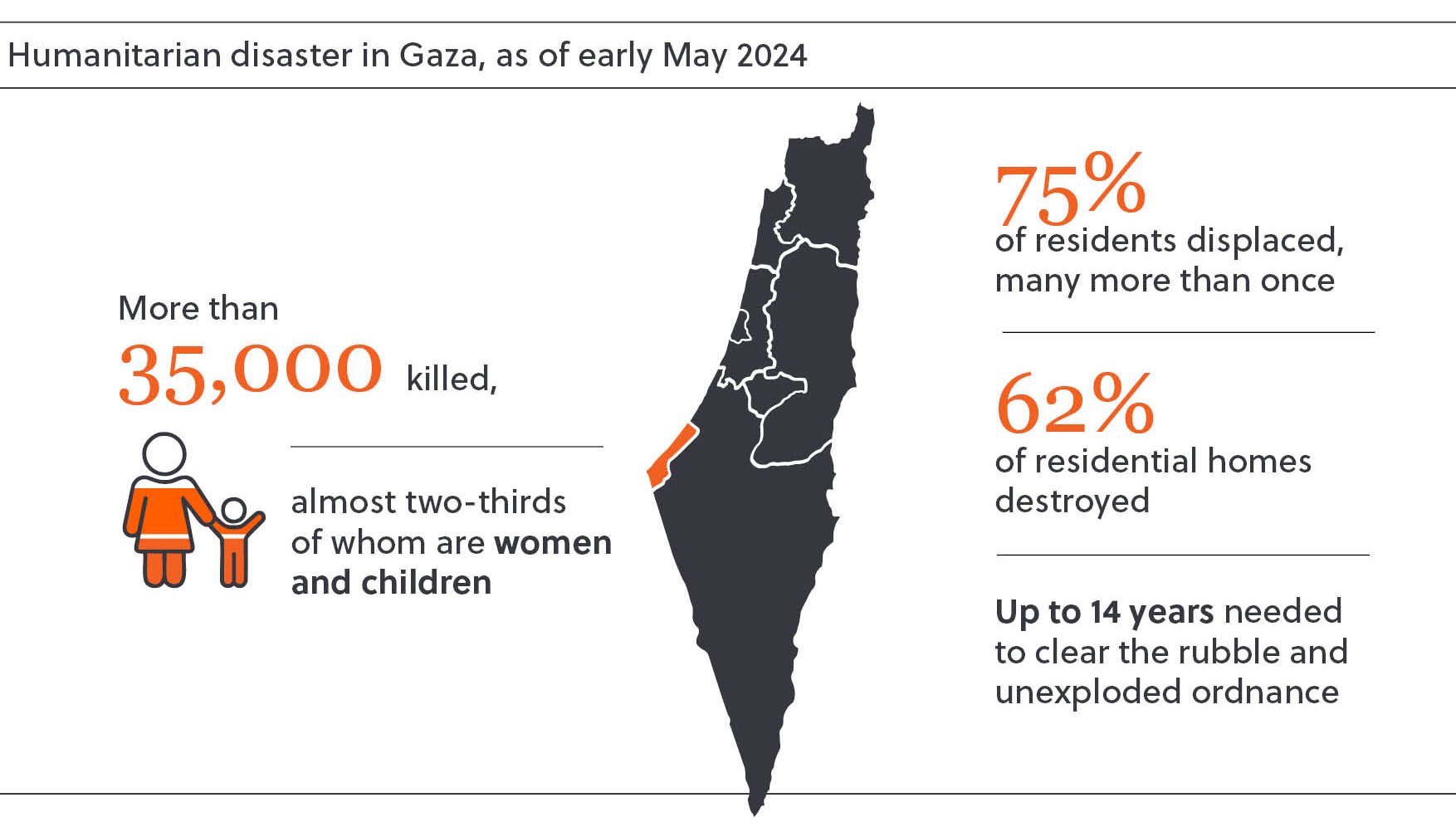More than seven months into Israel’s military campaign in the Gaza Strip, Tamsin Hunt examines Israel’s progress in achieving its stated objectives of dismantling Hamas’s leadership and combat capabilities.
On 7 October, in the aftermath of the Hamas attack on Israel, Prime Minister Benjamin Netanyahu vowed to destroy the organisation. On starting its ground offensive into the Gaza Strip that same month, Israel’s primary objective has been to destroy Hamas by demolishing the group’s political, military, and governance capabilities.
Despite these military successes, the complete neutralisation of Hamas remains an extremely challenging and potentially unattainable goal.”
More than seven months into its campaign, the Israel Defense Forces (IDF) had, by its own estimates, killed up to half of Hamas fighters, disabled 19 out of 24 Hamas battalions, and destroyed large parts of Hamas’s underground tunnel network. Although the details are difficult to verify independently in the fog of war, these operational achievements suggest that Israel has significantly diminished Hamas’s combat capabilities and its ability to command its forces. Despite these military successes, the complete neutralisation of Hamas remains an extremely challenging and potentially unattainable goal.
Difficult to pin down
One metric in measuring Israel’s achievements against Hamas is its success in dismantling the group’s top leadership. Here, Israel continues to face challenges. Many of Hamas’s senior leaders are located outside the Gaza Strip, in Lebanon, Qatar and Turkey. While Israel has successfully eliminated at least one senior Hamas leader in Beirut – Deputy Chief Saleh Al Arouri, killed in a targeted airstrike in January 2024 – Israel is unlikely to attempt such an action in Qatar or Turkey, as it would lead to serious diplomatic tensions and greater regional escalation. In Gaza, Israel has succeeded in killing only one of the three Hamas commanders suspected of planning the 7 October attack – Marwan Issa. Yahya Sinwar, the Hamas leader in Gaza, and Mohammed Deif, the commander of Hamas’s military wing, Al Qassam Brigades, continue to shelter in Gaza’s vast network of tunnels.
This underground network – made up of extensive tunnels, rooms, and hundreds of shafts to the surface – is integral to Hamas’s ability to move people and goods undetected around the Gaza Strip. By its secretive nature, the extent of the network is hard to quantify, and Israeli estimates of the destruction of the tunnel network vary widely, ranging from 20 to 80 percent. This means that, despite the significant margin of error, up to 80 percent of the tunnels may still be intact.
With Hamas’s manpower and weapons concealed beneath tunnels, and its senior leadership largely untouched, the group remains able to reassert itself in areas from which the IDF has withdrawn its troops, from Khan Younis to northern Gaza City. Despite months of heavy bombardment, Hamas fighters are still capable of ambushing IDF troops, engaging in skirmishes, and even firing rockets on Israeli territory, most notably killing four border guards in Kerem Shalom in May 2024.
A new generation of fighters
In addition to building its military capacity, Hamas has spent much of the past two decades rooting itself in civilian life, through governance, service delivery, and uniting Palestinians in the fight for statehood. Although Hamas may have lost many of its fighters, the group retains the capability to adapt and transform into a guerilla organisation, and will likely survive politically and ideologically for years to come.
While some Palestinians in Gaza may be ideologically opposed to Hamas or criticise its decision to attack Israel on 7 October, Israel’s forceful military response undermines its efforts to reduce Hamas’s legitimacy among ordinary Gazans. Beyond the high civilian casualty numbers and large-scale property destruction in Gaza, Israel’s obstruction of humanitarian aid and the undisciplined actions of its soldiers have further embedded the perception amongst many in Gaza – and incidentally, the West Bank – of Hamas as a symbol of resistance against Israeli occupation. While some IDF commanders have recently urged better behaviour from its soldiers, and pressure from the US has created inflows of aid to Gaza, it is widely perceived as too little, too late. Israel’s actions may instead serve to radicalise the next generation of Palestinian youth, creating a wealth of new recruits for a future armed uprising.

Sources: Palestine Ministry of Health; United Nations Relief and Works Agency of Palestine Refugees in the Near East (UNRWA); and United Nations Mine Action Service (UNMAS).
Failing to plan, or planning to fail?
Perhaps Israel’s most grievous mistake has been its failure to craft a clear political strategy for the future governance of Gaza. Despite rising calls to create such a plan, from both the US and stakeholders within Israel’s own war cabinet, Netanyahu and his right-wing allies remain determined to continue the offensive and focus on security issues alone.
As a result, Gaza is currently ungoverned and the people’s basic needs – such as food, water and some semblance of security – are distributed and controlled by a motley crew of criminal groups, armed militias, and the remnants of Hamas-run government ministries. Without a plan that goes beyond its current military campaign, Israel is failing to prepare for a governance vacuum that local armed groups are waiting in the wings to exploit. In the absence of a political strategy, especially one that addresses the needs of Palestinian civilians, Israel may continue to face the cycle of armed insurgencies and persistent anti-Israel sentiment that has marked the history of the Palestinian Territories since 1948.




